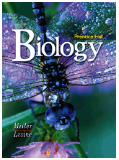BIOLOGY
by Miller & Levine
[complete Table of Contents]

|
Use the pull-down menu to jump to any of the Book's 40 Chapters: |
Additional Resources:
Neatly-Groomed
Mice
Is there a genetic basis for animal grooming? A new study on mice seems
to suggest that there may be.
Wired
Rats
Could rat behavior be coordinated by remote control? This article reports
on some recent experiments that have attempted to do just that.
In this chapter, students will read about the major types of innate and learned animal behavior and the significance of behavior as part of a reproductive strategy and a broader ecological adaptation. The links below lead to additional resources to help you with this chapter. These include Hot Links to Web sites related to the topics in this chapter, the Take It to the Net activities referred to in your textbook, a Self-Test you can use to test your knowledge of this chapter, and Teaching Links that instructors may find useful for their students.
| Hot Links | Chapter Self-Test |
| Take it to the Net | Teaching Links |
What are Web Codes? |
Web
Codes for Chapter 34: |
![]()
Section 34-1: Elements of Behavior
![]() When an animal
responds to a stimulus, body systems—including the sense organs,
nervous system, and muscles—interact to produce the resultant behavior.
When an animal
responds to a stimulus, body systems—including the sense organs,
nervous system, and muscles—interact to produce the resultant behavior.
![]() Innate behaviors
appear in fully functional form the first time they are performed, even
though the animal may have had no previous experience with the stimuli
to which it responds.
Innate behaviors
appear in fully functional form the first time they are performed, even
though the animal may have had no previous experience with the stimuli
to which it responds.
![]() The four major
types of learning are habituation, classical conditioning, operant conditioning,
and insight learning.
The four major
types of learning are habituation, classical conditioning, operant conditioning,
and insight learning.
Section 34-2: Patterns of Behavior
![]() Many animals respond
to periodic changes in the environment with daily or seasonal cycles of
behavior.
Many animals respond
to periodic changes in the environment with daily or seasonal cycles of
behavior.
![]() To pass along
its genes to the next generation, any animal that reproduces sexually
needs to locate and mate with another member of its species at least once.
Courtship behavior helps many animals identify healthy mates.
To pass along
its genes to the next generation, any animal that reproduces sexually
needs to locate and mate with another member of its species at least once.
Courtship behavior helps many animals identify healthy mates.
![]() Usually, members
of a society are related to one another. Related individuals share a large
proportion of each other's genes. Therefore, helping a relative survive
increases the chance that the genes an individual shares with that relative
will be passed along to the next generation of offspring.
Usually, members
of a society are related to one another. Related individuals share a large
proportion of each other's genes. Therefore, helping a relative survive
increases the chance that the genes an individual shares with that relative
will be passed along to the next generation of offspring.
![]() Animals may use
visual, sound, touch, or chemical signals to communicate with one another.
Animals may use
visual, sound, touch, or chemical signals to communicate with one another.